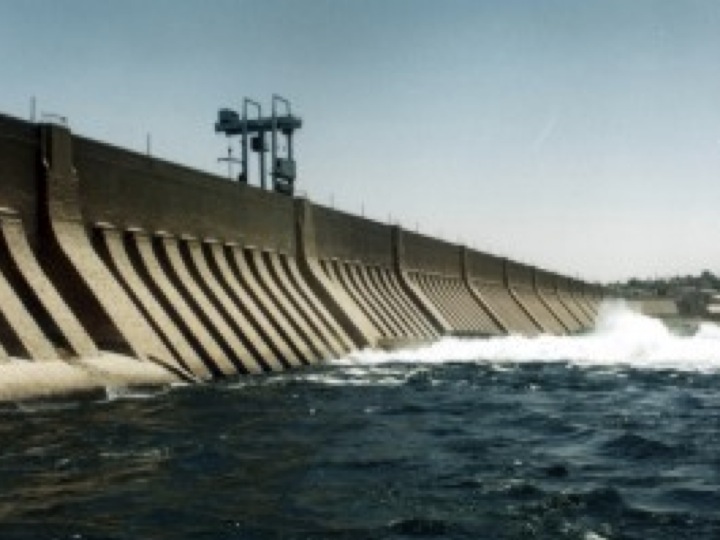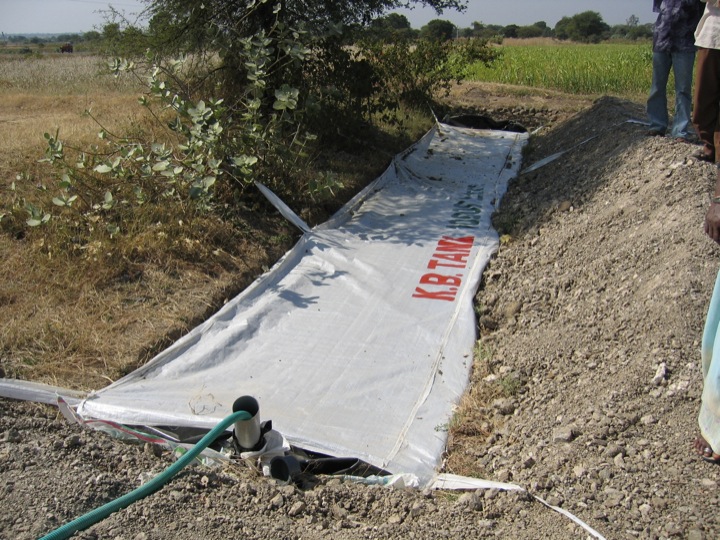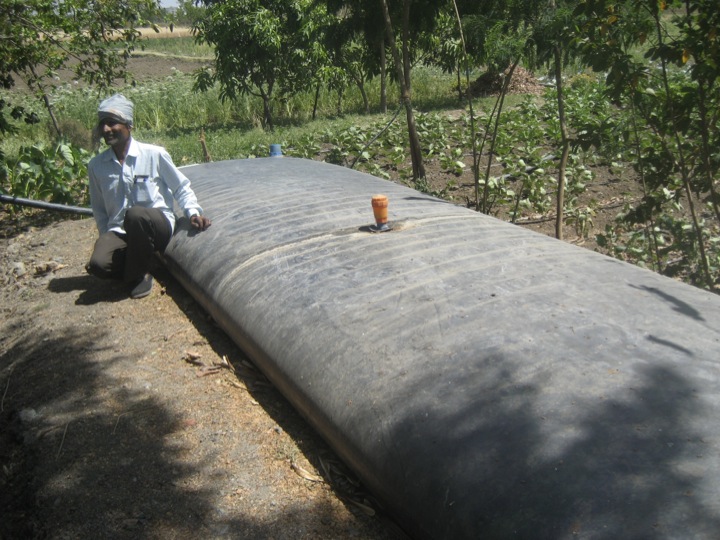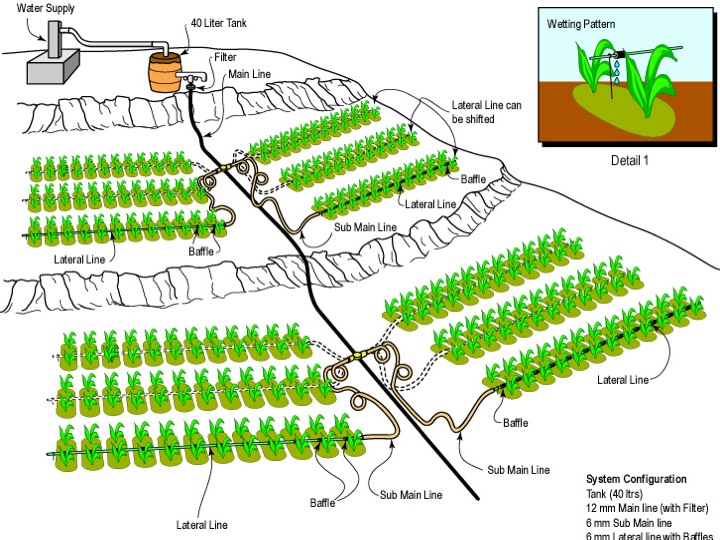Replicating the Functions of the Aswan Dam on Two Acre Farms:

Like all big dams, the High Aswan dam traps monsoon rainwater and stores it in the 550 km long Nasser Lake behind it, and distributes it
by canal to farmers’ fields during dry season, when irrigation water is desperately needed to grow crops. But can we do the same thing on-farm for the 450 million farms in the world that are smaller than five acres? This would make a game-changing contribution to ending extreme poverty and food insecurity at the same time.
The remarkable thing is that this is entirely feasible. It takes two things:
1. The design and mass dissemination of new radically affordable small enclosed water storage technology, which is already well under way
2. The design of small plot low cost drip irrigation systems to deliver the stored water to farmers’ fields. Through the work of IDE, 500,000 small farmers in Asia and Africa have already purchased the low cost drip system
Most rural villages in developing countries already know how to collect monsoon rainwater. The trick is to store it in such a way that it doesn’t evaporate during the six month wait till the dry season, when crop prices are the highest and water is most precious. The source can be monsoon rainwater from a roof, or collecting runoff at the lowest point on a small farm. They key missing link is affordable enclosed water storage.
1. Affordable enclosed water storage
A Giant Plastic Condom in an Earthen Trench The first thing we tried as simple way to store water was a ten meter long one meter diameter plastic sausage, supported by an earthen trench. This stored just under 10,000 liters, enough to provide all the drinking water a family needs and have enough left over to drip irrigate a small kitchen garden. But we had problems with leakage.

The 5,000 L $75 Durable Plastic Bladder Five years later, after a lot of field trials, Jack Keller and J.N. Rai at IDE India have come up with a sturdy thicker walled plastic bladder that stores 5,000 liters of water, it doesn’t leak, and costs about $75. This is just beginning to be marketed, and I think it will make a big impact.
The 200,000 L $500 Plastic Lined Pond with a Plastic Cover This is probably the most important missing link for millions of future NAWSA MAD systems. It takes about 200,000 liters to drip irrigate a quarter acre of off-season fruits, vegetables and spices for 90 days in the dry season, which is capable of bringing in $1,000 in new net income in the dry season. All it would take is a common plastic lined pond ten meters long, ten meters wide, and two meters deep. Now add a 11 meter by 11 meter plastic sheet stretched over bamboo poles to cover the pond, and pile dirt on the overhanging edges of the plastic sheet, and you have a $500 enclosed plastic 200 cu M storage tank, which needs an additional investment of about $200 in a treadle pump, a quarter acre low cost drip system, seeds and fertilizer, and you have new income of $1,000 in the first year. This would be enough to pay back all the capital costs, earn $300 in new net income, and earn $1,000 a year in new income from then on.
2. Low Cost Small Plot Drip Irrigation Systems
Over the last ten years, IDE and its partners have developed a variety of affordable drip irrigation systems for small plots, starting with a $3 kitchen garden kit irrigating 20 square meters, all the way to a one acre drip system costing in the range of $400. Since they generate returns of 200 percent or more on their purchase price, smallholders can buy at whatever size they can afford and expand their system each year with part of the profits they make. Low cost drip systems, combined with affordable enclosed water storage, form the backbone of micro Aswan dam water storage and distribution systems for small farms.
If you want to see what such a low cost micro version of the Aswan Dam looks like on a small farm in India, take a look at this video. I made it in India six years ago, but the main idea still applies.




This has wonderful potential for the emerging New Ag in the United States and elsewhere in the developed economies.
The language and concepts of small scale irrigation systems are not, generally, well understood by USDA field personnel. Their experience comes from very large scale pivot systems.
This observation comes straight from a friend’s experience in developing about 14 acres of former soybean fields into a market garden enterprise (with success)integrating a lower elevation storage pond, terrace systems, and eventual wind power to pump from pond to higher holding tanks.
The field knowledge is coming along, and the USDA people are driven to help, but with a lot of work by US early adopters educating the USDA local folks on the benefits of small scale drip irrigation.
What I particularly enjoy are there are so many BOP projects that will readily migrate to our New Ag here in the US, where water is fast becoming this century’s “Oil Crisis”.
Keep up the great, pragmatic, and beautifully inexpensive innovations.
Dear Mike
I totally agree with you- one of the most exciting features of successful BOP projects is that their key features are very much applicable to small farms in the US and Europe, of course with adaptation and field tests to the conditions of small farms in the west.
thank you for your encouragement!
paul polak
Pingback: The NAWSA MAD SYSTEM (ASWAN DAM Backwards) « StLeoScience
I’ve added this to a 45 page link table with descriptions on water resources – http://water.re-configure.org
This also reminds me of this video “Greening the Desert” on permaculture methods that seem like they should be employed in more parts of the world at least as experiments
http://www.youtube.com/earthintelnet#p/f/254/4S6kTlz6Mk4
dear JZ
Thank you for linking us to http://water.re-configure.org and http://www.youtube.com/earthintelnet#p/f/254/4S6kTlz6Mk4- I love them both!
paul polak
Great article. Remember, filtration is vital to a good drip system. Drip can solve many water shortage issues and many companies are pushing drip, especially subsurface drip with great success. Subsurface drip tape is used extensively for tomato, cotton and alfalfa production.
You actually make it appear so easy along with your presentation but I in finding this topic to be actually one thing that I think I’d never understand. It sort of feels too complicated and extremely wide for me. I’m looking ahead to your next publish, I¡¦ll try to get the hold of it!